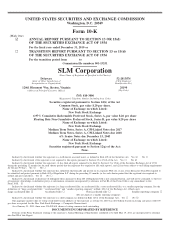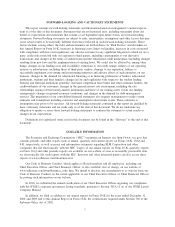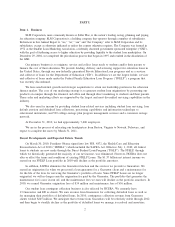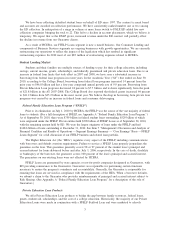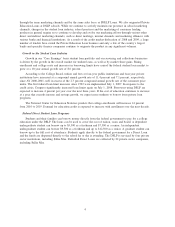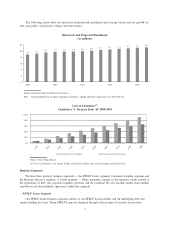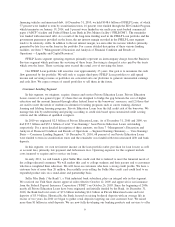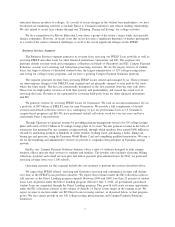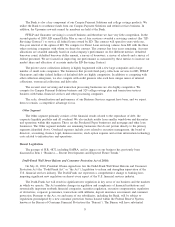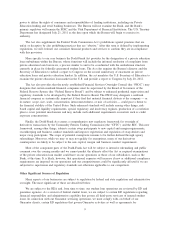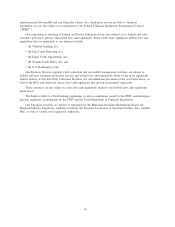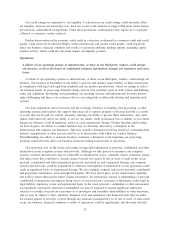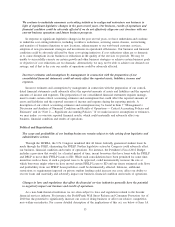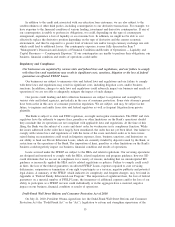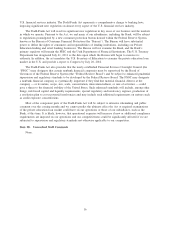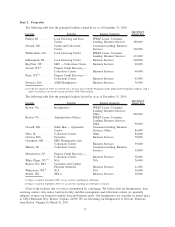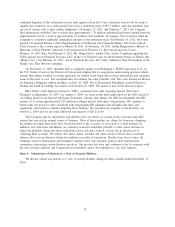Sallie Mae 2010 Annual Report Download - page 10
Download and view the complete annual report
Please find page 10 of the 2010 Sallie Mae annual report below. You can navigate through the pages in the report by either clicking on the pages listed below, or by using the keyword search tool below to find specific information within the annual report.power to define the rights of consumers and responsibilities of lending institutions, including our Private
Education lending and retail banking businesses. The Bureau will not examine the Bank, and the Bank’s
primary regulators will remain the FDIC and the Utah Department of Financial Institutions. The U.S. Treasury
Department has designated July 21, 2011 as the date upon which the Bureau will begin to exercise its
authority.
The Act also supplements the Federal Trade Commission Act’s prohibitions against practices that are
unfair or deceptive by also prohibiting practices that are “abusive.” After this term is defined by implementing
regulations, we will evaluate our consumer financial products and services to confirm they are in compliance
with this provision.
More specific to our core business the Dodd-Frank Act provides for the designation of a private education
loan ombudsman within the Bureau, whose functions will include the informal resolution of complaints from
private education loan borrowers, a process similar to and to be coordinated with the ombudsman structure
currently in place for federally guaranteed student loans. The Act also requires the Bureau’s director and the
Secretary of Education to submit a report to Congress on the second anniversary of enactment on private
education loans and private education lenders. In addition, the act mandates the U.S. Secretary of Education to
examine the private education loan market in the U.S. and provide a report to Congress by July 20, 2012.
The Act also provides that the newly established Financial Services Oversight Council (the “FSOC”) may
designate that certain nonbank financial companies must be supervised by the Board of Governors of the
Federal Reserve System (the “Federal Reserve Board”) and be subject to enhanced prudential supervision and
regulatory standards to be developed by the Federal Reserve Board. The FSOC may designate a nonbank
financial company as systemically important if they find that material financial distress at the company — or
its nature, scope, size, scale, concentration, interconnectedness, or mix of activities — could pose a threat to
the financial stability of the United States. Such enhanced standards will include among other things, risk-
based capital and liquidity requirements, special regulatory and insolvency regimes, production of a resolution
plan to cover potential insolvencies and may include such additional requirements on matters such as credit
exposure concentrations.
Finally, the Dodd-Frank Act creates a comprehensive new regulatory framework for oversight of
derivatives transactions by the Commodity Futures Trading Commission (the “CFTC”) and the SEC. This new
framework, among other things, subjects certain swap participants to new capital and margin requirements,
recordkeeping and business conduct standards and imposes registration and regulation of swap dealers and
major swap participants. The scope of potential exemptions remains to be further defined through agency
rulemakings. Moreover, while we may or may not qualify for exemptions, many of our derivatives
counterparties are likely to be subject to the new capital, margin and business conduct requirements.
Most of the component parts of the Dodd-Frank Act will be subject to intensive rulemaking and public
comment over the coming months and we cannot predict the ultimate effect the Act or required examinations
of the private education loan market could have on our operations or those of our subsidiaries, such as the
Bank, at this time. It is likely, however, that operational expenses will increase if new or additional compliance
requirements are imposed on our operations and our competitiveness could be significantly affected if we are
subjected to supervision and regulatory standards not otherwise applicable to our competitors.
Other Significant Sources of Regulation
Many aspects of our businesses are subject to regulation by federal and state regulation and administrative
oversight. The most significant of these are described below.
We are subject to the HEA and, from time to time, our student loan operations are reviewed by ED and
guarantee agencies. As a servicer of federal student loans, we are subject to certain ED regulations regarding
financial responsibility and administrative capability that govern all third-party servicers of insured student
loans. In connection with our Guarantor servicing operations, we must comply with, on behalf of our
Guarantor clients, certain ED regulations that govern Guarantor activities as well as agreements for
9

